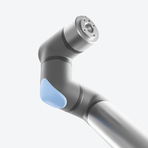The idea of using collaborative robots for lights-out manufacturing can seem like a contradiction in terms. After all, cobots differ from traditional robots by being able to work side-by-side with human workers, and lights-out manufacturing is a human-free automation approach. But the collaborative aspect of cobots is more...
Cobots in Lights-Out Manufacturing? - Collaboration

The idea of using collaborative robots for lights-out manufacturing can seem like a contradiction in terms. After all, cobots differ from traditional robots by being able to work side-by-side with human workers, and lights-out manufacturing is a human-free automation approach. But the collaborative aspect of cobots is more than just the ability to share a work cell. Cobots are also defined by their affordability, flexibility, and ease-of-use—traits that are critical for new lights-out applications.
LIGHTS-OUT MANUFACTURING IS GETTING SMALLER
Factories with no humans in sight are still rare and are typically limited to extremely high-volume, high-cost operations. The vast majority of manufacturers are small and mid-sized enterprises (SMEs), with limited automation budgets to support what is often low-volume, high-mix, or changeable applications.
Many SMEs are interested in a lights-out approach for third-shift operations or to address seasonal peaks. In today’s market, where manufacturers are struggling to hire and retain workers as well as meet quality and delivery expectations, those additional shifts can be difficult—and expensive—to staff. In other situations, manufacturers may choose to use lights-out automation for specific processes that are unsuitable or unsafe for human workers to be around, such as those that involve extreme temperatures or noxious gases.
INVEST IN ADDITIONAL CNC MACHINE, OR INCREASE CAPACITY OF THE ONE IN-HOUSE?
New Jersey-based Whippany Actuation Systems makes components for the aerospace and defense industries. When the company suddenly needed to increase capacity, the options were to make a significant investment in an additional CNC machine or to make better use of the one in-house. A UR cobot with an adaptive gripper now handles multiple part sizes and allows Whippany to run two additional unattended shifts using the existing CNC machine.
Phil De Mauro, Whippany manufacturing engineering leader, said, “We’ve added capacity by being able to run the machine during unattended hours, but it’s also freed-up skilled workers to do other tasks as opposed to loading and unloading the machine—it frees them up to do more value-added activities.”
Lights-out automation has helped Whippany meet its increased productivity goals, but it also helps in other factors, such as improved margins, increased competitiveness, and shortened lead time. Read the full Whippany case study.
COBOT STAYS UP LATE TO BE READY FOR HUMAN WORKERS IN THE MORNING
Creating Revolutions is a Florida-based startup that makes a customer-service paging system for the hospitality industry. As a startup, budgets are tight, but the company was struggling to meet demand and maintain quality in its product’s complex assembly process. The solution was an affordable, easy-to-program UR cobot integrated by Hirebotics in an innovative rental model in which Creating Revolutions pays only for the hours the cobot operates.
The cobot solves the manufacturer’s need for accuracy and throughput while working alongside human workers during the day. But the cobot also continues to perform long after workers go home for the night, preparing parts for assembly the next day.
Hirebotics Co-founder Matt Bush says, “Most companies are years away from lights-out manufacturing because it’s so capital intensive. But by renting robots by the hour, and only paying for the hours they actually work, companies of all sizes can afford to automate more of their processes.” Hirebotics’ cloud-connected solution includes high-definition cameras and a web-based interface that lets the manufacturer and Hirebotics monitor the robot on any smartphone. The software also provides insight into precise production data around the clock. Read the full Creating Revolutions case study.





Round-the-clock production helps startup scale-up
Voodoo Manufacturing in Brooklyn, New York is a rapidly growing 3D printing farm that is scaling up to handle large production runs to compete with traditional plastic injection molding manufacturing. “Harvesting” is the process of loading and unloading 3D printer plates, which takes up about 10% of all labor hours. This repetitive task requires speed, accuracy, and consistency—making it ideal for automation. And using UR cobots allows the company to automate at about one-fifth the cost of traditional robotics that require safety cages and expensive integration.
Voodoo installed the cobot on a mobile base so it can tend up to one hundred 3D printers. With a second cobot, the startup will go from 30%-40% printer utilization to 90%. The key to tripling output is the ability for the cobot to tend printers overnight.
Jonathan Schwartz, Chief Product Officer of Voodoo Manufacturing, says, “We can monitor the robot through our own software and access the status of any given printer to see whether it’s printing or idle, which means we can deploy this in our factory and run it 24/7 without any human oversight.” Schwartz describes the first morning he came in to find more than 30 completed print runs handled overnight as “magical.” Read the full Voodoo Manufacturing case study.
COBOTS MAKE LIGHTS-OUT MANUFACTURING A REALITY—EVEN FOR SMALL OPERATIONS
Affordable, flexible, and easy-to-use cobots are making lights-out manufacturing an option even for smaller operations. With the addition of innovative Industry 4.0 technologies, companies can monitor what’s happening after the lights go out, and enjoy the increased output when workers arrive in the morning.
Download the ebook “Get Your Team On Board with Cobots”
https://info.universal-robots.com/en/get-your-team-on-board-with-cobots

- Universal Robots USA, Inc
- 27175 Haggerty Road, Suite 160
- 48377 Novi, MI